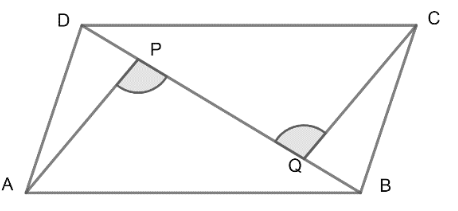
ABCD is a parallelogram AP and CQ are perpendicular drawn from vertices A and C on diagonal BD (see figure) show that AP = CQ.


Answer
591.9k+ views
Hint: We will first start by using the fact that if two triangles are congruent then their corresponding parts are equal for proving two triangles congruent. We will use AAS congruency wherein we have to prove two angles and one side are equal.
Complete step-by-step solution -
Now, we have been given a parallelogram and AP and CQ are perpendicular drawn from vertices A and C and diagonal BD and we have to show that AP = CQ.

Now, we know that opposite sides of a parallelogram are parallel and equal. Therefore, we have,
$AD=BC ......................\left( 1 \right)$
Also, we have $AD\parallel BC$ and we know that alternate interior angles formed by a transversal cutting a pair of parallel lines are equal. Therefore we have,
$\angle 1=\angle 2 ...............\left( 2 \right)$
Now, we know that the angle formed by a straight line is $180{}^\circ $. Therefore, we have,
$\begin{align}
& \angle DPA+90{}^\circ =180{}^\circ \\
& \Rightarrow \angle DPA=90{}^\circ \\
& \angle CQB+90{}^\circ =180{}^\circ \\
& \Rightarrow \angle CQB=90{}^\circ \\
& \Rightarrow \angle DPA=\angle CQB .................\left( 3 \right) \\
\end{align}$
Now, we have in $\Delta DPA$ and $\Delta BQC$,
$\begin{align}
& \angle DPA=\angle BQC \\
& AD=CB \\
& \angle 1=\angle 2 \\
\end{align}$
Hence, $\Delta DPA\cong \Delta BQC$ by AAS congruency.
Now, we know that by the corresponding part of the congruent triangle we have,
AP = CQ
Hence proved.
Note: It is important to note that we have used a fact that the sum of the linear pair of angles is $180{}^\circ $. Therefore, we have $\angle APD=\angle CQB=90{}^\circ $. Also, we have used a fact that the opposite sides of a parallelogram are equal and parallel. It is also worthwhile to remember that the alternate interior angle formed by a transversal on a pair of parallel lines are equal.
Complete step-by-step solution -
Now, we have been given a parallelogram and AP and CQ are perpendicular drawn from vertices A and C and diagonal BD and we have to show that AP = CQ.

Now, we know that opposite sides of a parallelogram are parallel and equal. Therefore, we have,
$AD=BC ......................\left( 1 \right)$
Also, we have $AD\parallel BC$ and we know that alternate interior angles formed by a transversal cutting a pair of parallel lines are equal. Therefore we have,
$\angle 1=\angle 2 ...............\left( 2 \right)$
Now, we know that the angle formed by a straight line is $180{}^\circ $. Therefore, we have,
$\begin{align}
& \angle DPA+90{}^\circ =180{}^\circ \\
& \Rightarrow \angle DPA=90{}^\circ \\
& \angle CQB+90{}^\circ =180{}^\circ \\
& \Rightarrow \angle CQB=90{}^\circ \\
& \Rightarrow \angle DPA=\angle CQB .................\left( 3 \right) \\
\end{align}$
Now, we have in $\Delta DPA$ and $\Delta BQC$,
$\begin{align}
& \angle DPA=\angle BQC \\
& AD=CB \\
& \angle 1=\angle 2 \\
\end{align}$
Hence, $\Delta DPA\cong \Delta BQC$ by AAS congruency.
Now, we know that by the corresponding part of the congruent triangle we have,
AP = CQ
Hence proved.
Note: It is important to note that we have used a fact that the sum of the linear pair of angles is $180{}^\circ $. Therefore, we have $\angle APD=\angle CQB=90{}^\circ $. Also, we have used a fact that the opposite sides of a parallelogram are equal and parallel. It is also worthwhile to remember that the alternate interior angle formed by a transversal on a pair of parallel lines are equal.
Recently Updated Pages
Master Class 10 General Knowledge: Engaging Questions & Answers for Success

Master Class 10 Science: Engaging Questions & Answers for Success

Master Class 10 Social Science: Engaging Questions & Answers for Success

Master Class 10 Maths: Engaging Questions & Answers for Success

Master Class 10 English: Engaging Questions & Answers for Success

Master Class 10 Computer Science: Engaging Questions & Answers for Success

Trending doubts
The shortest day of the year in India

Why is there a time difference of about 5 hours between class 10 social science CBSE

Write a letter to the principal requesting him to grant class 10 english CBSE

What is the median of the first 10 natural numbers class 10 maths CBSE

The Equation xxx + 2 is Satisfied when x is Equal to Class 10 Maths

State and prove converse of BPT Basic Proportionality class 10 maths CBSE




